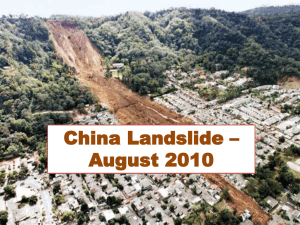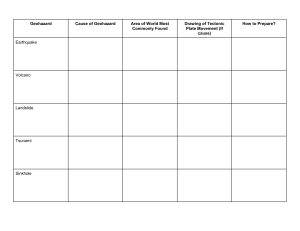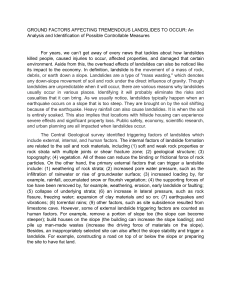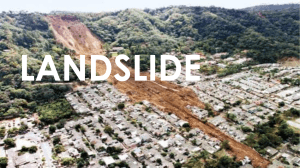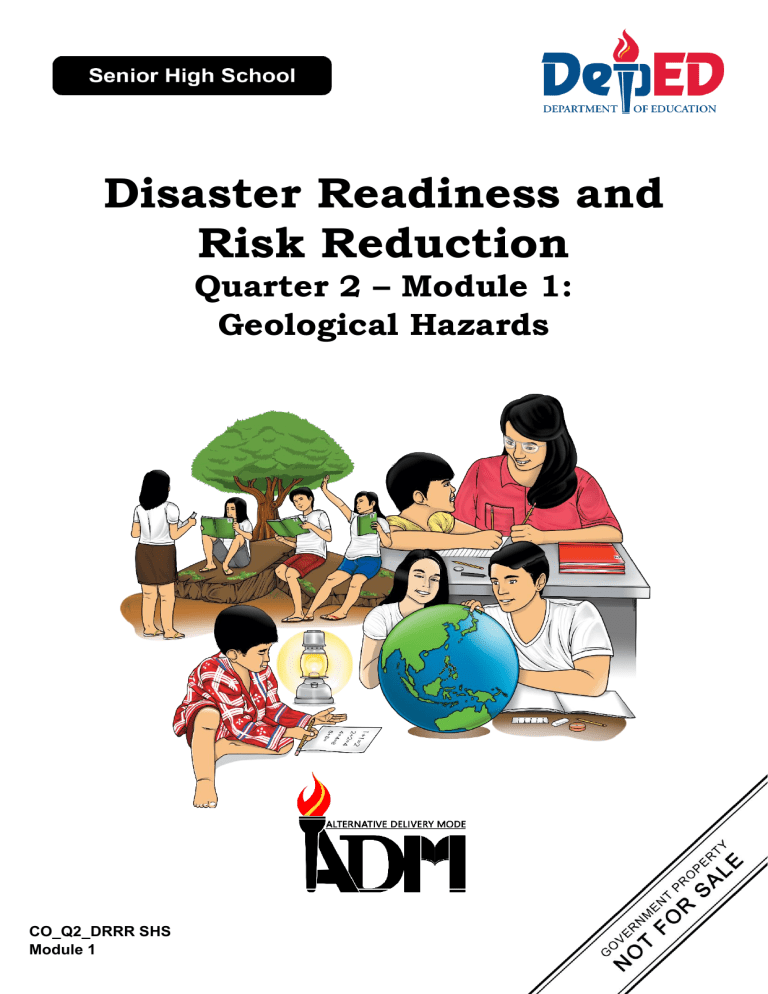
Disaster Readiness and Risk Reduction Quarter 2 – Module 1: Geological Hazards CO_Q2_DRRR SHS Module 1 Disaster Readiness and Risk Reduction Alternative Delivery Mode Quarter 2 – Module 1: Geological Hazards First Edition, 2021 Republic Act 8293, section 176 states that: No copyright shall subsist in any work of the Government of the Philippines. However, prior approval of the government agency or office wherein the work is created shall be necessary for exploitation of such work for profit. Such agency or office may, among other things, impose as a condition the payment of royalties. Borrowed materials (i.e., songs, stories, poems, pictures, photos, brand names, trademarks, etc.) included in this module are owned by their respective copyright holders. Every effort has been exerted to locate and seek permission to use these materials from their respective copyright owners. The publisher and authors do not represent nor claim ownership over them. Published by the Department of Education Secretary: Leonor Magtolis Briones Undersecretary: Diosdado M. San Antonio Development Team of the Module Writer: Jimmy D. Geron Hazel Ann S. Llamas Ruby C. Bautista Editors: Anne Marielle R. Del Mundo Vanessa A. Bautista Reviewers: Richard Brian B. Tutor; Gerry Romero; Reggie Ilag Yumi Angela S. Valderama Illustrator: Ronan DC Vergara Layout Artist: Maria Elinor F. Hemedes; Ren Mac Mac G. Motas Management Team: Francis Cesar Bringas Job S. Zape Jr. Eugenio S. Adrao Elaine T. Balaogan Fe M. Ong-ongowan Susan DL Oribiana Jaypee E. Lopo Dolorosa S. De Castro Cristeta M. Arcos Printed in the Philippines by ________________________ Department of Education – Region IV-A CALABARZON Office Address: Telefax: E-mail Address: Gate 2 Karangalan Village, Barangay San Isidro Cainta, Rizal 1800 02-8682-5773/8684-4914/8647-7487 region4a@deped.gov.ph Disaster Readiness and Risk Reduction Quarter 2 – Module 1: Geological Hazards Introductory Message This Self-Learning Module (SLM) is prepared so that you, our dear learners, can continue your studies and learn while at home. Activities, questions, directions, exercises, and discussions are carefully stated for you to understand each lesson. Each SLM is composed of different parts. Each part shall guide you step-bystep as you discover and understand the lesson prepared for you. Pre-tests are provided to measure your prior knowledge on lessons in each SLM. This will tell you if you need to proceed on completing this module or if you need to ask your facilitator or your teacher’s assistance for better understanding of the lesson. At the end of each module, you need to answer the post-test to self-check your learning. Answer keys are provided for each activity and test. We trust that you will be honest in using these. In addition to the material in the main text, Notes to the Teacher are also provided to our facilitators and parents for strategies and reminders on how they can best help you on your home-based learning. Please use this module with care. Do not put unnecessary marks on any part of this SLM. Use a separate sheet of paper in answering the exercises and tests. And read the instructions carefully before performing each task. If you have any questions in using this SLM or any difficulty in answering the tasks in this module, do not hesitate to consult your teacher or facilitator. Thank you. 1 CO_Q2_DRRR SHS Module 1 What I Need to Know This module was designed and written with you in mind. It is here to help you master the Other Related Geologic Hazards. The scope of this module permits it to be used in many different learning situations. The language used recognizes the diverse vocabulary level of students. The lessons are arranged to follow the standard sequence of the course. But the order in which you read them can be changed to correspond with the textbook you are now using. The module focuses only about the lesson: Lesson 1 – Knowing different geological hazards After going through this module, you are expected to: 1. Understand what a Rainfall-induced Landslide and sinkhole is. 2. Describe in his/her own words the definition of a landslide and a sinkhole. 3. Explain the different types of landslides and sinkholes. 4. Produce a poster or a slogan regarding Landslide and Sinkhole. 5. Realize the importance of creating warning signs for the safety of living creatures and mankind. 2 CO_Q2_DRRR SHS Module 1 What I Know Pre-test The Philippines is located in an archipelago characterized by having mountainous terrains and is often visited by typhoons which bring heavy rain. These two conditions combined in the most unfavorable manner may cause landslides and sinkholes which are potential geologic hazard due to the topographic and geologic composition of land. Landslides and sinkholes are often referred to as a generic name for soil collapsing downward but it also has different types and characteristics based on its composition. Read each item comprehensively and write the letter of the correct answer on extra sheet of paper. 1. Landslide is the downward ground movement on a sloping terrain caused by gravity. It also comes in scientific term such as ________. a. land agitation c. landslip b. landmass d. land tremors 2. Which of the following is a natural agent of erosion which flows and loosens the soil? a. air c. butane b. alcohol d. water 3. What type of landslide has a very slow movement which is hardly noticeable? a. debris flow c. slumping b. rock fall d. soil creep 4. Which of the following happens when the slope becomes saturated with water triggering a landslide of water sacked mass of rock and soil? a. debris flow c. slumping b. rock fall d. soil creep 5. Which of the following pertains to a sudden slide of rocks downslope? a. rock failure c. rock slip b. rock fall d. rock stead 6. Which of the following is a landslide characterized by short distance movement down a slope, sliding along concave-upward or planar surface? a. debris flow b. slumping c.soil creep d. topples 3 CO_Q2_DRRR SHS Module 1 7. Which of the following is not a condition for a landslide to occur? a. bare vegetation c. heavy rain b. flat terrain d. inclined location 8. This is a depression in the ground that resulted from the collapse of the surface layer of the soil. a. earthquake b. landslide c. sinkhole d. tsunami 9. Which of the following characteristics of a rock is essential in order to produce a sinkhole? a. dense b. hard c. lustrous d. soluble 10. Which of the following is not an ideal environment for sinkholes to occur? a. limestone saturated c. sedimentary deposits b. salt beds d. volcanic craters 11. Which of the following is a type of sinkhole that develops abruptly which cause catastrophic damage? a. artificial b. cover collapse c. cover subsidence d. dissolution 12. What type of sinkhole develops gradually where the covering sediments are permeable and contain sand? a. artificial b. cover collapse c. cover subsidence d. dissolution 13. Which of the following occurs in areas where limestone is exposed at land surface? a. artificial b. cover collapse c. cover subsidence d. dissolution 14. Which of the following sinkholes is primarily caused by various human activities including groundwater pumping and construction activities? a. artificial b. cover collapse c. cover subsidence d. dissolution 15. Which of the following is always true about sinkholes? a. can only form holes b. can be shallow or deep c. can only occur on land d. can form above igneous rocks 4 CO_Q2_DRRR SHS Module 1 Lesson 1 Explain Different Types of Geological Hazards Geological hazards are natural phenomena that cause major problems around the world. The expansion and development of cities has led to an increase in impact and damage due to geological hazards. In general, most of the geological hazards are related to natural conditions, although some may be due to human activities. While landslides come in various names such as mudslide, flash flood, avalanche, etc. The actual difference is in their composition provided that there is an inclined terrain. Sinkholes, on the other hand, can occur on elevated or flat surfaces and can range from massive to barely noticeable which may leave a dent, a hole, or a body of water on the ground. Therefore, as a student you need to be aware of the different types of landslides and sinkholes in order to be prepared for the danger that it may cause. 5 CO_Q2_DRRR SHS Module 1 Image Source: “24 Shocking Before-After Photos You Won't Believe Are Real: Natural Disasters, Geology, Before after Photo.” Pinterest. Accessed July 1, 2020. https://www.pinterest.ph/pin/232568768230237588/. What’s In Activity 1: Essay. Direction: Analyze the illustration and answer the following questions thoroughly. This is a before and after illustration of a debris avalanche of Mount Pinatubo located on the tripoint boundary of the Philippine provinces of Zambales, Tarlac and Pampanga, all in Central Luzon on the northern part of Luzon. Based from the illustration, answer the following question below. Guide questions: 1. Why do volcanoes erupt? What happened to the appearance of the crater after the volcanic eruption? __________________________________________ __________________________________________ 2. What happened to the portions of the volcano that were removed? _________________________________________ _________________________________________ 3. What geologic hazard could be responsible for the movement of the soil? _________________________________________ _________________________________________ 6 CO_Q2_DRRR SHS Module 1 What’s New Activity 2: Present a situation. Direction: These are the some of the landslide precaution signs often found on the roadsides. Answer the following questions below. 1. Have you ever seen one of these signages on the roadsides? If yes, where, and when? 2. What do these signages mean? 3. Why is the second image highlighted in red? 4. When and where did you see these road signs? 5. What is common in these places where they are placed? Top Gobierno de Colombia (2012). Colombia road sign SP-42. https://commons.wik imedia .org/wiki/File:Colo mbia_road_sign_SP42.svg#file. Marked under Public Domain Bottom Global Panorama (2014). Landslide sign. Digital Art. https://search.creativ ecommons.org /photos/adf1c896b48b-4d0c-923a- 7 CO_Q2_DRRR SHS Module 1 What is It ❖ Landslide A landslide is a ground movement on a sloping terrain. It does not happen on flat ground because of the angle on the ground, gravity induces the land to move downward. It is aggravated by rain because water is a natural agent for erosion. If rain or any source of water frequently flows down a sloping area, the gravitational descent of loosened soil makes it possible for landslide to occur. Structures that are built on steep-slope mountains have a high vulnerability to landslide hazards especially during heavy rains. Areas with: steep slope, dense population and denuded terrain are distinguished by a high susceptibility to rainfall-induced landslide hazards. Long or regular rain may saturate the topsoil and the bedrock, weakening the soil base of buildings or structures. Without plants and trees whose roots can absorb water and hold the soil together, subsequent rain water can continue to loosen up the soil that anchors the buildings. A heavy downpour of rain can quickly destroy these buildings and communities, giving way to landslides, mudslides, or mudflows. Types of Landslide 1. Soil Creep Landslide is a very slow downslope movement of particles that occurs in every slope covered with loose, weathered material (Britannica dictionary). 2. Slumping Landslide is a downward movement of rock debris, usually the consequence of removal of buttressing earth at the foot of a slope of unconsolidated material (Britannica dictionary). 8 CO_Q2_DRRR SHS Module 1 3. Debris Flow Landslide happens when the slope becomes saturated with water, this then triggers a landslide of water-soaked mass of rock and soil that slides down the slope. 4. Rock Fall landslides are sudden slides caused by heavy rain the rock on the slope loosens and then slides down the slope. ❖ Sinkhole A sinkhole is a topographic depression created when groundwater dissolves the underlying limestone bedrock. Often known as "sink" or "doline,". Characteristics: ● occur in areas where the soil foundation is made of soft minerals and rocks such as limestone, salt beds, or any acidic rocks. ● The depth of sinkholes ranges from a couple of meters to several mile deep. How it occurs: Water from the rainfall seeps underneath the soil through the cracks and fissures. As water passes through these cracks and fissures, it erodes the soil and forms a conduit system, these underground water systems increase in size as the soil is carried by the water through internal erosion. This can either form a void filled with air with an underground drainage. If the void is clogged with clay, then it forms a depression which then accumulates water and forms a pond. Otherwise it forms a hole once the cover collapses into the void which can be either filled with air or water. 9 CO_Q2_DRRR SHS Module 1 Types of Sinkholes There are three main types of sinkholes, according to the geologist, but there is an additional category, the artificial sinkholes which are caused by human activity. 1. Cover Collapse Sinkhole It develops suddenly (over an hour period) thus, causing catastrophic damage. 2. Cover Subsidence Sinkhole It gradually grows where the sediment covers are permeable and contain sand. 3. Dissolution Sinkhole It occurs in areas where calcareous is exposed on the ground or where thin layers of soil and permeable sand are also covered. Limestone or dolomite dissolution is most intense when the water first reaches the rock surface. 4. Artificial Sinkhole Such types of sinks may be caused by various human activities, including groundwater pumping and building. What’s More Activity 3: Modified TRUE or FALSE Read each item carefully and choose the best answer. Write your answer on a separate sheet of paper. Write TRUE if the statement is correct. If the statement is false, change the underlined word/s to make the statement true. ___________1. An avalanche is a form of landslide. ___________2. Sinkholes form in sedimentary rock deposits. ___________3. A earthquake is a topographic depression created when groundwater dissolves the underlying limestone bedrock ___________4. Landslide does happen on flat ground because of the angle on the ground, gravity induces the land to move downward. ___________5. One of the characteristics of landslide is the depth of holes ranges from a couple of meters to several mile deep. ___________6. Debris Flow Landslides are sudden slides caused by heavy rain the rock on the slope loosens and then slides down the slope. ___________7. Rock Fall Landslide happens when the slope becomes saturated with water, this then triggers a landslide of water-soaked mass of rock and soil that slides down the slope. 10 CO_Q2_DRRR SHS Module 1 ___________8. Soil Creep Landslide is a very slow downslope movement of particles that occurs in every slope covered with loose, weathered material ___________9. Slumping Landslide is a downward movement of rock debris, usually the consequence of removal of buttressing earth at the foot of a slope of unconsolidated material ___________10. Depressions on the ground that resulted from the collapse of the surface layer of the soil is called a sinkhole. Activity 4: Complete the statements. Directions: Landslide and sinkholes are both geological hazards but are distinctly different. Complete the following paragraphs based on what you have learned in the lecture. Rubrics: You will be given 10 points for each paragraph,1 point for each line and four points for the last line if you have properly stated the difference between the four types. Landslide I have learned that landslides are ________________________ and they are formed by _________________________ which has four types namely, __________________, ________________, ______________, _______________. The difference between each type is ___________________________________________. Sinkhole I have learned that sinkholes are ___________________________ which are formed by __________________________ that has four different types namely: __________________, ___________________, ________________, _________________. The difference between these sinkholes is that _______________________________________________________________________. 11 CO_Q2_DRRR SHS Module 1 What I Can Do Activity 5: Create an evacuation plan for your household whenever a landslide or sinkhole may occur. Countercheck the location of your home in google maps or you could use the Project NOAH app of DOST and provide an escape route. Evaluate the risk of your location to landslides and sinkholes. Use a bond paper and make use of arrows, different colors of ink and standard symbols for clearer representation. Your plan should include the following: a. Floor plan of your household and location of possible exit and entry points. Also indicate blocked exits. b. Location of your house on a geologic hazard map. c. A specific rendezvous point where you and your family members will meet. d. Include at least three exit plans from at least three different locations of your household. e. You must create a Legend panel to contain the meaning of the symbols that you have used. Symbols must include the following: - “X” mark of areas prone to landslide and sinkhole. - “O” mark for evacuation areas and safe zones. - “- - -” dashed lines to indicate direction of evacuation 12 CO_Q2_DRRR SHS Module 1 Rubrics for scoring: Criteria 4 3 2 1 Accuracy and Relevance All information is correct and all of the sources are listed Most of the information is correct and most of the sources are listed Some of the information is correct and some of the sources are listed Originality With One or two exceptional of the degree of graphics student reflects creativity in creativity of their work. the students The plan All required includes elements required are included elements as on the flyer well as additional information in the legend pane All writing is Most of the tidy, photos writing is and artwork tidy, photos are precisely and artwork placed, and are mostly all sections placed are orderly carefully, and most of the sections are orderly Graphics made based on the designs of others Very little of the information is correct and none of the sources are listed No graphics made by the student are included Required Elements Neatness Creativity Colorful The plan as a whole is interesting, engaging, imaginative, and original The floor plan is eye catching and vibrant and/or coordinated colors are used Most of the plan is interesting, engaging, imaginative, and original Most of the floor plan is eye catching and bright colors and/or mostly coordinated colors are used 13 TOTAL SCORE All but 1 are included on the flyer Several required elements are missing Some of the writing is tidy, photos and artwork are somewhat placed carefully, and some of the sections are orderly Some of the plan is interesting, engaging, imaginative, and original Some of the floor plan is eye catching and average and/or some mismatched colors are used Very little of the writing is tidy, photos and artwork are placed poorly, and the sections are disorderly Very little of the plan is interesting, engaging, imaginative, and original Very little of the floor plan is eye catching and dull and/or mismatched colors are used CO_Q2_DRRR SHS Module 1 Assessment Read each item comprehensively and write the letter of the correct answer on extra sheet of paper. 1. Which of the following is a type of sinkhole that develops abruptly which cause catastrophic damage? a. artificial c. cover subsidence b. cover collapse d. dissolution 2. What type of sinkhole develops gradually where the covering sediments are permeable and contain sand? a. artificial c. cover subsidence b. cover collapse d. dissolution 3. Which of the following occurs in areas where limestone is exposed at land surface? a. artificial b. cover collapse c. cover subsidence d. dissolution 4. Which of the following sinkholes is primarily caused by various human activities including groundwater pumping and construction activities? a. artificial c. cover subsidence b. cover collapse d. dissolution 5. Which of the following is always true about sinkholes? a. can only form holes c. can only occur on land b. can be shallow or deep d. can form above igneous rocks 6. Which of the following is a landslide characterized by short distance movement down a slope, sliding along concave-upward or planar surface? a. debris flow c. soil creep b. slumping d. topples 7. Which of the following is not a condition for a landslide to occur? a. bare vegetation b. flat terrain c. heavy rain d. inclined location 8. This is a depression in the ground that resulted from the collapse of the surface layer of the soil. a. earthquake b. landslide c. sinkhole d. tsunami 9. Which of the following characteristics of a rock is essential in order to produce a sinkhole? a. b. dense hard c. lustrous d. soluble 14 CO_Q2_DRRR SHS Module 1 10. Which of the following is not an ideal environment for sinkholes to occur? a. limestone saturated b. salt beds c. sedimentary deposits d. volcanic craters 1. Landslide is the downward ground movement on a sloping terrain caused by gravity. It also comes scientific term such as ________. a. land agitation b. landmass c. landslip d. land tremors 2. Which of the following is a natural agent of erosion which flows and loosens the soil? a. air b. alcohol c. butane d. water 3. What type of landslide has a very slow movement which is hardly noticeable? a. debris flow b. rock fall c. slumping d. soil creep 4. Which of the following pertains to a sudden slide of rocks downslope? a. rock failure b. rock fall c. rock slip d. rock stead 5. Which of the following happens when the slope becomes saturated with water triggering a landslide of water sacked mass of rock and soil? a. debris flow b. rock fall c. slumping d. soil creep Additional Activities Enrichment Activity Directions: Make an infographics that gives warning to people about the types of landslides and sinkholes. An infographics is a graphic visual representation of information, data or knowledge intended to present information quickly and clearly to the viewers. This includes illustrations and descriptions. Put your work on a short bond paper. Criteria Accuracy and Relevance 4 3 2 1 All information is correct and all of Most of the information is correct and most of Some of the information is correct and some of Very little of the information is correct and none of the TOTAL SCORE Originality Required Elements Neatness Creativity Colorful the sources are listed With exceptional degree of student creativity in their work. The infographics includes required elements as well as additional information in the legend pane All writing is tidy, photos and artwork are precisely placed, and all sections are orderly The infographics as a whole is interesting, engaging, imaginative, and original The infographics is eye catching and vibrant and/or coordinated colors are used the sources are listed One or two of the graphics reflects creativity of the students All required elements are included Most of the writing is tidy, photos and artwork are mostly placed carefully, and most of the sections are orderly Most of the infographics is interesting, engaging, imaginative, and original Most of the infographics is eye catching and bright colors and/or mostly coordinated colors are used the sources are listed Graphics made based on the designs of others sources are listed No graphics made by the student are included All but 1 are included Several required elements are missing Some of the writing is tidy, photos and artwork are somewhat placed carefully, and some of the sections are orderly Some of the infographics is interesting, engaging, imaginative, and original Very little of the writing is tidy, photos and artwork are placed poorly, and the sections are disorderly Some of the infographics is eye catching and average and/or some mismatched colors are used Very little of the poster/slogan is eye catching and dull and/or mismatched colors are used Very little of the infographics is interesting, engaging, imaginative, and original Post-test B C D A B B B C D D B D D B A What's More PRE-TEST 1. TRUE B 2. TRUE D 3. SINKHOLE D DOES NOT 4. A HAPPEN B SUNKHOLE 5. B ROCK FALL 6. LANDSLIDES B 7. C DEBRIS FLOW LANDSLIDES D 8. D TRUE 9. B TRUE 10. TRUE C D A B What's In Possible Answers: Larger/ wider crater, deformed landscape Possible Answers: it fell down the volcano, it melted, it was carried to the foot of the volcano by the lava Possible Answers: avalanche-is also a landslide with ice and soil, mudflow, landslide Answer Key References 210 Lab #2. Accessed July 1, 2020. /bselleck/geol210/lab2/slump.htm. http://classes.colgate.edu “24 Shocking Before-After Photos You Won't Believe Are Real: Natural Disasters, Geology, Before after Photo.” Pinterest. Accessed July 1, 2020. https://www.pinterest.ph/pin/232568768230237588/. “Landslides Warning Sign Vector Images (over 180).” VectorStock. Accessed July 1, 2020. https://www.vectorstock.com/royalty-freevectors/landslides-warning-sign-vectors Landslides. (n.d.). Retrieved July 01, 2020, klamathcounty.org/812/Landslides from https://www. Landslides - All the different Kinds: Landslide, Diagram, Geology. (n.d.). Retrieved July 01, 2020, from https://www.pinterest .ph/pin/394768723579480675/ Maynard, Barry. “Landslide Types-Creep.” Flickr. Yahoo!, December 2, 2008. https://www.flickr.com/photos/fenneman/3076572501. “Traffic Sign Landslide Warning Sign Rock, Rock, Angle, Text, Triangle Png.” PNGWing. Accessed July 1, 2020. https://www.pngwing.com/en/free-png-xmgit. Villamor S. Quebral, Ed.D., ”Disaster Readiness and Risk Reduction”, Lorimar Publishing Inc.,2016, pp58-71 For inquiries or feedback, please write or call: Department of Education - Bureau of Learning Resources (DepEd-BLR) Ground Floor, Bonifacio Bldg., DepEd Complex Meralco Avenue, Pasig City, Philippines 1600 Telefax: (632) 8634-1072; 8634-1054; 8631-4985 Email Address: blr.lrqad@deped.gov.ph * blr.lrpd@deped.gov.ph
